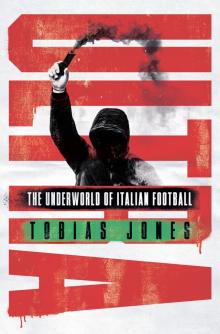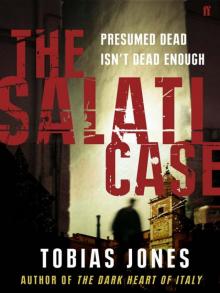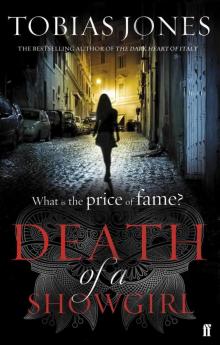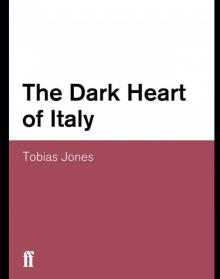- Home
- Tobias Jones
The Dark Heart of Italy Page 19
The Dark Heart of Italy Read online
Page 19
Thus, Clean Hands is being rewritten, and the revolution has almost come a full circle. Those who once seemed to promise a cleaner future have been suspected of dirty pasts. The defence line of those accused is incredibly clever. The Second Republic, they say, is really very different to the First, and you can’t judge one according to the rules of the other. Before 1992 corruption was so rife in the upper echelons of politics and finance that it was impossible not to collude in some way. Now that Clean Hands has taught us all a lesson, we should wipe the slate clean and start over again. Berlusconi’s best defence, one which can only be deployed through hint rather than admission, is that he was only ever doing what everyone else was doing during the old days of the salotto buono. It’s exactly the same line that Bettino Craxi used in 1992, when he deployed the classic Italian defence not that he was innocent, but that everyone else was just as guilty. Craxi admitted to ‘an irregular system of financing’, but underlined that ‘all the parties took part in it’. According to that defence, the only difference between Berlusconi or Craxi and their electorates is the scale, rather than the character, of the crime; and if that’s true, it’s obvious that any punishment that is meted out appears excruciatingly selective.
Maybe Craxi wasn’t any worse than any of us; maybe, the Forza Italia rhetoric goes, Berlusconi is no worse than us, and we’re hypocrites if we pretend he is. Some Italian commentators, like Pietro Scoppola, have said precisely that: the lynching of high-ranking politicians was supported by the public since it represented some kind of vicarious absolution: we’re all guilty and we needed ‘illustrious’ names to redeem us of our sins. When the revolution began to reach lesser names and impose ‘cleanliness’ instead of ‘cunning’, the bedrock of support for the magistrates collapsed.
Thus the fact that Berlusconi is under accusation only means that the magistrates are biased against him. He has, in fact, become a master of the art of vittimismo, complaining that every accusation against him is simply the work of those ‘Jacobin judges’. Seven years after he offered Antonio Di Pietro a job, Berlusconi now says: ‘Tangentopoli never existed. Clean Hands was only a colossal conquest commissioned by the Communists and Democrats of the Left’. Thus, according to the man who most benefited from the whole affair, Clean Hands wasn’t cleaning up Italian democracy at all, but actually strangling it. There was, say his supporters, an excess of protagonismo, in which a handful of judges suddenly appeared to enjoy rather too much their centre-stage; the leaks to the press about imminent arrests turned the judicial process into spectacular, televisual witch-hunts; the ‘cautionary custody’, which locked up politicians for months on end, was an abuse of judicial power, especially since white collar criminals pose no threat to society.
There are many responses to that ‘restoration’ defence. First, they portray all Italians as being as crooked as the billionaires with offshore accounts. Clean Hands, from what I can work out, happened precisely because noble men were prepared to risk their lives and their businesses to root out corruption. Since, at the most conservative estimates, that corruption had cost the Italian economy one trillion lire, those magistrates were supported by millions of Italians. They equated corruption not with ‘backdoor capitalism’ or harmless cunning, but with theft, pure and simple. They would be appalled to be put in the same bracket as the ‘corrupters’ and told that così fan tutti, ‘everyone’s up to something’. In fact the honesty of Italy’s moral minority is all the more amazing because it comes in a context in which cunning and corruption are never punished. Luca Magni, the man who denounced Mario Chiesa, now says wistfully about the entire episode: ‘From Tangentopoli I’ve had only problems, starting with the bankruptcy of my business, whilst he [Mario Chiesa] has been fined seven billion lire, but has kept another five billion. The moral of the Clean Hands fable is, as far as I’m concerned, that in this country those who are honest are losers.’
Second, there’s a lazy use of terminology. Corruption is, as I’ve said, like Parma’s prosciutto. It’s only a generic term. There’s a difference between the corruption of ‘irregular financing’ (payments to political parties in return for the right contracts) and the corruption of personal bank accounts (which enrich politicians rather than their policies). There’s a difference between those who (because of poverty or unemployment) earn ‘in the black’ and those businessmen throughout Milan who admitted paying billions of lire in bribes to politicians and police. Third, it’s true that judges often appeared rather vain, long-winded, certainly not camera-shy; and it’s true that ‘cautionary custody’ was a shock tactic which led to shocking suicides. But for years Italy’s petty criminals, even its ‘illustrious accused’ like Sofri, had endured such treatment; and the argument that Sofri is more dangerous to society than white collar criminals is simply absurd. In fact, politicians only woke up to the procedural problems of Italian justice (they started talking about habeas corpus and human rights) once they were subjected to it, rather than exploiting it.
It was, by then, January 2001, almost exactly nine years after the arrest of Mario Chiesa. Berlusconi’s face was grinning from huge posters across the country promising ‘pensions’ or ‘work’ to his electorate. Whilst I was trying to follow the unfathomable rhetoric of the election campaign, a tragic story began dominating the newspapers. A countess, Francesca Vacca Agusta, had gone missing from her cliff-top villa in Portofino, the jewel of the Italian riviera in Liguria. That was at the beginning of January. Only her dressing gown had been found bobbing in the Ligurian sea. Vacca Agusta was found two weeks later, washed up in France. It was to that countess that billions of lire were transferred in the spring of 1993, just as the Clean Hands operation was getting to the upper-ranks of parliament. Craxi had ordered one of his henchmen to empty his banks of billions of lire and transfer them to the countess as a ‘dummy holder’ of the money. She had duly fled to Mexico, only to return to Italy to endure ‘house arrest’. Her death may well have been the tragic accident the inquest found it to be (she had apparently slipped during a late-night bout of hide-and-seek), but her central role in the Clean Hands enigma was yet another reason to revisit the revolution and ask where Craxi’s billions had gone, if indeed they ever really existed.
By then, he had died in exile in Tunisia; ‘they killed him’ said his outraged daughter, with reference to the Clean Hands judges and their ‘mob’ supporters. Thus, as with most revolutions, the consequences had become somehow completely the opposite of what was hoped for. In its zealousness, Clean Hands had yielded its moral high-ground to the ‘restoration’ forces, headed by one of Craxi’s closest friends, Silvio Berlusconi.
March 2001. I was sitting in the pub one night. It was the Dubh Linn just by the duomo. Giovanni was opposite me, lighting another Diana cigarette. He stared at the packet on the table and asked me if it was true that the British secret services had bumped off Princess Diana. He, like hundreds of my students, was convinced of it.
‘No, no,’ I said, suddenly offended that someone was slandering my country. Thinking about it, though, perhaps that’s exactly what I was doing to his country: believing all the conspiracy theories, and understanding absolutely nothing… writing scurrilous essays which only showed Italy in the worst possible light. Maybe, I suddenly thought, all these tragic stories aren’t real at all. Maybe they never actually happened, and I’ve simply fallen victim to Italy’s most pervasive ailment: paranoia. It’s so contagious, though, that everyone is as paranoid as they are cunning. No one in Britain really believes that dozens of the country’s suicides and murders are linked, that they’re the central strand of a sad national story. In Italy, there’s barely anyone who doesn’t think that. And no political party has a monopoly on the paranoia. Berlusconi himself is the most paranoid of all. In Italy everyone I spoke to, be they academics, journalists, politicians, judges or students, every book I read, seemed paranoid: uncertain of what was happening, but pessimistic about the unseen ‘puppeteers’ who pulled the strings or the triggers. As I w
rote about the country’s bitter historical debates, I found myself reflecting that pessimism. I didn’t necessarily believe it all, but, I reasoned, to ignore that pessimism and paranoia would have been to edit out the emotional atmosphere of Italian life.
Giovanni, probably seeing that I was rather too deep in thought, decided I needed to get out of Parma for a while. He invited me to his house, hundreds of miles to the south, in Puglia. ‘That’s where Padre Pio lived,’ he said, explaining that it was Padre Pio’s face I kept seeing framed in shops, resting on endless mantelpieces, adorning key-rings or zippo lighters. His was the only face in Italy with more exposure than Berlusconi’s. ‘You need a pilgrimage,’ he said, stubbing out his cigarette.
References - 6 Clean Hands
1 Eurostat, Enterprises in Europe (Brussels, 1996)
2 Quoted in The New York Review of Books (October 18, 2001)
3 Carlo Pirovano ed., Italia moderna: la difficile democrazia (Milan, 1985)
4 Ibid
5 Corriere della Sera (3 May 1992)
6 Paul Ginsborg, L’Italia del tempo presente (Turin, 1998)
7 Corriere della Sera (29 May 1992)
8 Il Giornale (27 January 1994)
7
Miracles and Mysteries
Italy is a land full of ancient cults, rich in natural and supernatural powers. And so everyone feels its influence. After all, whoever seeks God, finds him… wherever he wants…
Federico Fellini
At the beginning of the twentieth century, San Giovanni Rotondo was a tiny village in the rugged Gargano mountains of Puglia, the region that forms the heel and spur of the Italian boot. Even forty years ago it was linked to Manfredonia (the nearby port) only by a mule track that zigzagged down through olive trees to the Adriatic. Now, though, San Giovanni Rotondo is Italy’s most-visited tourist spot, welcoming more than six million visitors a year. It has overtaken Lourdes as Europe’s most popular destination for Catholic pilgrims. It has more than a hundred alberghi and hotels, and will soon have a new cathedral designed by Renzo Piano. There is also an imposing new hospital, one of Italy’s largest and most modern.
Behind all this is San Giovanni’s most revered son, and one of the best-known Italians of the twentieth century: Padre Pio. When he was beatified on 2 May 1999, most of the country became immersed in preparation for the big event (even the Serie A game between Roma and Inter was postponed to the following day). Pope John Paul II celebrated a televised mass in St Peter’s, and then travelled down to San Giovanni Rotondo to celebrate mass there. The million pellegrini in attendance were transported by more than 5,000 coaches (100 from Poland alone) and 19 special trains. 1,000 chemical toilets were set up in the village and big CCTV screens surrounded its two main squares.
Long before San Giovanni Rotondo became famous, another nearby village, Monte Sant’Angelo, was a place of pilgrimage: the village formed the end of the medieval pilgrim ‘Route of the Angel’, which wound its way from Normandy to Rome and beyond. The reason for its fame is a mixture of local lore and millennial angst. The story goes that, in 490 AD, a local man went up into the mountains, searching for his prize bull. He found it at the entrance to a cave, way up on the most precarious promontory. The bull was reluctant to move, so the man shot an arrow at it: the arrow turned in the wind and embedded itself in the man’s forehead. The Bishop of Siponto was called on for advice, and when he arrived at the grotto he received a visitation from the Archangel Michael, who ordered him to consecrate a Christian altar on the site. It’s not known what happened to the man with the arrow in his forehead, but the result of his misadventure was the famous Santuario di San Michele. In 999 AD, the Holy Roman Emperor, Otto III, made a pilgrimage to the sanctuary, and prayed that the apocalypse prophesied for the end of the first millennium wouldn’t happen. A thousand years later and the same worries, together with the beatification of Padre Pio, prompted a sudden risveglio, or reawakening, of religious piety and pilgrimage.
I’m met off the train at Manfredonia by my friend Giovanni whose family live in the town. It’s almost midnight and he drives me to my hotel. By the reception desk there’s a cabinet of Padre Pio mementos – letter-racks, mirrors, diaries, plates, each one bearing his by now familiar image: a high forehead, grey beard and bushy eyebrows, deep-set eyes above a slightly bulbous nose. The set of his mouth makes him look as if he is wincing. He seems kindly but austere. A sleeve, or more usually a finger-less glove, covers up the reason for his fame – his stigmata. Giovanni says it’s a farce: ‘This used to be one of the poorest parts of Italy, but it has suddenly become very wealthy, simply because of Padre Pio.’
Padre Pio was born Francesco Forgione in 1887 in Pietrelcina, a small town half-way between Naples and Manfredonia. He was ordained into the order of Capuchin monks in 1910 and moved to San Giovanni Rotondo in 1916. He stayed there, almost always within the Chiesa di Santa Maria delle Grazie, until his death, at 81, in September 1968. Almost exactly fifty years before, on 20 September 1918, he became the only Catholic priest to have received stigmata. A month after the wounds appeared, he wrote to his spiritual adviser, Padre Benedetto, describing what had happened:
After I had celebrated Mass, I yielded to a drowsiness similar to a sweet sleep. All the internal and external senses and even the very faculties of my soul were immersed in indescribable stillness. Absolute silence surrounded and invaded me. I was suddenly filled with great peace and abandonment which effaced everything else and caused a lull in the turmoil. All this happened in a flash… I became aware that my hands, feet and side were dripping blood. Imagine the agony I experienced and continue to experience almost every day. The heart wound bleeds continually, especially from Thursday evening until Saturday. Dear Father, I am dying of pain because of the wounds and the resulting embarrassment I feel in my soul. I am afraid I shall bleed to death if the Lord doesn’t hear my heartfelt supplication to relieve me of this condition. Will Jesus, who is so good, grant me this grace? Will he at least free me from the embarrassment caused by these outward signs?
Between the wars, Padre Pio’s fame grew, thanks to the stigmata and the endless stories about his miracles: there were tales of bilocation (being in two places at the same time), inexplicable cures, celestial perfumes, instant conversions and prophetic visions. Every Italian seems to have a favourite anecdote: he blessed a pile of envelopes brought to him, but refused to bless one (when it was opened it was found to contain coupons for the football pools); he knelt to pray for George VI before his death had been announced; he appeared in the cockpit of an American aircraft during bombing missions in the Second World War. His most celebrated feat was to have picked out a letter from Poland, which pleaded for his intercession on behalf of a mortally ill woman. ‘We cannot say no to this one,’ Padre Pio is supposed to have declared. The woman recovered and the Polish priest who had written on her behalf, Bishop Wojtyla, subsequently became better known as Pope John Paul II.
Until recently, however, Padre Pio’s relations with the higher echelons of the Catholic church were strained. Doctors were repeatedly sent to inspect his wounds, and there was an attempt to have him transferred to Spain (averted only by the intervention of the Ministry of the Interior). But Padre Pio’s admirers have included Gabriele D’Annunzio, who was one of his correspondents; the TV presenter, Luciano Rispoli, at whose marriage he officiated; the show-girl Lorella Cuccarini likes to drop his name in interviews. The magazine Gente – a cross between Hello! and the Catholic Herald – regularly runs new anecdotes about him, and offers readers cassettes of ‘his actual voice’. Abroad he’s just as popular: the Padre Pio Foundation of America has a doting website, and there’s a bookshop entirely devoted to him in Vauxhall Bridge Road in London.
In November 1969 it was decreed that he had died in odore di santità (the ‘scent of saintliness’) and the case for his beatification was formally put by the Bishop of Manfredonia. The process is a tortuous one: first, the Tribunale Diocesano gives its verdict, then the matter is
passed on to the Congregazione per le Cause dei Santi in Rome. The theologians and cardinals on this committee reexamine all the relevant writings and testimonies and, if they are satisfied that someone deserves to be recognised as a beato, medical evidence is called on to demonstrate that miracles occurred as a result of his or her intercession.
The day Giovanni and I arrive in San Giovanni Rotondo it is raining heavily and the town – with its roads and woodlands disappearing into the low clouds – resembles a new ski resort. There are cranes everywhere, constantly gyrating as they lift lumps of concrete into place for the next huge hotel. Opposite the façade of Santa Maria delle Grazie are a series of staircases that rise high into the hills, flanked by statues of the Padre and the Madonna. Nearby, a portakabin serves as the studio of the official radio station, La Voce di Padre Pio.
There is normally a three-hour wait to get into the Chiesa, though we get in quite quickly thanks to the rain. The hushed queue snakes round the monastery, past strategic notices and collection boxes. You can get objects blessed every fifteen minutes and a line of people has already formed with wedding rings or car keys at the ready. The Padre’s tomb is a massive marble edifice, surrounded by wrought-iron railings and boxes into which photographs and letters can be posted. Some two hundred people are gathered round it, lighting candles, falling to their knees and whispering prayers.
There’s a spontaneous outburst of Hail Marys as we approach Padre Pio’s sealed-off cell, above which are written Thomas à Kempis’s words from The Imitation of Christ: ‘Worldly honours have always sorrow for company’. Through the glass you can see every book, painting, photograph, as well as his comb, perfectly preserved. The bed is made, and by it are his size-nine shoes, purple-black and almost as wide as they are long because of the bleeding and swelling. In the nearby chapel a plaque marks Pio’s seat, and the exact location in which he first received the stigmata. Facing the piazza outside, still teeming with pilgrims, is a narrow window. It was here that, like the Pope, Padre Pio used to bless his visitors, raising his hands so that everyone could get a look at his bandages.

 Ultra
Ultra The Salati Case
The Salati Case Death of a Showgirl
Death of a Showgirl The Dark Heart of Italy
The Dark Heart of Italy